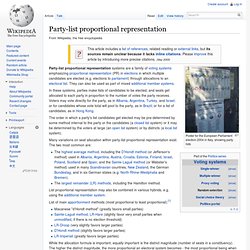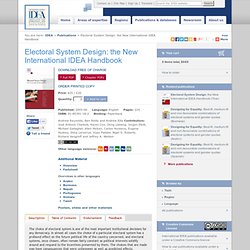

Rob Ford’s good shot at re-election another reason for electoral reform. So, just to catch you up with all the latest on Toronto’s mayor: The police were reportedly aware of the infamous video of the mayor allegedly smoking crack weeks before it was shown to the Toronto Star; the mayor’s name is also reported to have been mentioned in discussions picked up on police wiretaps, part of a year-long investigation culminating in this week’s massive raid on an apartment complex in the city’s western suburbs — the same one where the mayor is reported to have told staff the video could be found.

Andrew Coyne: Toronto voting proposal might be last shot at electoral reform in Canada Sometime later this spring a small bomb is set to go off in Toronto. Don’t be alarmed: I mean only a vote of the city council. But it is a vote with potentially ground-shaking implications. Continue reading… Now for the bad news. Toronto’s most notable division is between its suburbs and its inner core, the enduring legacy of the city’s forced amalgamation in 1998.
Postmedia News. List proportional representation. Poster for the European Parliament election 2004 in Italy, showing party lists Party-list proportional representation systems are a family of voting systems emphasizing proportional representation (PR) in elections in which multiple candidates are elected (e.g. elections to parliament) through allocations to an electoral list.

They can also be used as part of mixed additional member systems. In these systems, parties make lists of candidates to be elected, and seats get allocated to each party in proportion to the number of votes the party receives. Voters may vote directly for the party, as in Albania, Argentina, Turkey, and Israel; or for candidates whose vote total will pool to the party, as in Brazil; or for a list of candidates, as in Hong Kong. Many variations on seat allocation within party-list proportional representation exist. List proportional representation may also be combined in various hybrids, e.g. using the additional member system. See also[edit] References[edit] IDEA: International Institute for Democracy and Electoral Assistance. Electoral System Design: the New International IDEA Handbook. You are using an old web browser in which the Unified Database may not be fully functional.

The choice of electoral system is one of the most important institutional decisions for any democracy. In almost all cases the choice of a particular electoral system has a profound effect on the future political life of the country concerned, and electoral systems, once chosen, often remain fairly constant as political interests solidify around and respond to the incentives presented by them. The choices that are made may have consequences that were unforeseen as well as predicted effects. Electoral system choice is a fundamentally political process, rather than a question to which independent technical experts can produce a single ‘correct answer’.
The consideration of political advantage is almost always a factor in the choice of electoral systems. "Design of electoral systems is a most fundamental factor to democratic strengthening in the world. We would like to know, for example: Which voting system is best? With the day of the referendum on the UK voting system drawing nearer, Tony Crilly uses a toy example to compare the first past the post, AV and Condorcet voting systems, and revisits a famous mathematical theorem which shows that there is nothing obvious about voting.

How to choose a winner? The good folk of Chuddlehampton have to elect their village councillor, the person to represent them at the Regional Council. "Go and elect someone" was the only instruction they were given. So how were they to go about it? The village elders supervising the vote soon found there were many ways this could be done. It seemed there were three main methods available: The first-past-the-post (FPTP) methodThe alternative vote (AV) methodThe Condorcet method. Having studied the matter, the elders could not decide which one to choose. So the electorate of twenty villagers assembled at the voting station and filled out their voting slips. We'll see how the candidates fared under each of the systems: